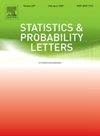广义全称推理中的多重检验
IF 0.7
4区 数学
Q3 STATISTICS & PROBABILITY
引用次数: 0
摘要
与p值相比,e值可证明地保证安全、有效的推理。应用通常需要同时考虑多个假设,并且可以在相关文献中找到使用e值处理此类情况的工具。然而,标准的e值结构所要求的分布假设可能是不合理的。本文证明,当兴趣量是风险函数的最小值时,根据不同的测试环境,广义通用推理框架非常适合与现有的e值合并和调整策略一起使用,以控制多重测试中的频率错误率,从而避免了对某些分布假设的需要。我们在涉及分位数回归显著性检验的模拟研究中证明了这种一般方法的强大性能。本文章由计算机程序翻译,如有差异,请以英文原文为准。
Multiple testing in generalized universal inference
Compared to p-values, e-values provably guarantee safe, valid inference. Applications often require consideration of multiple hypotheses simultaneously, and tools for handling such cases using e-values can be found in the relevant literature. Standard e-value constructions, however, require distributional assumptions that may not be justifiable. This short paper demonstrates that, depending on the multiple testing context, the generalized universal inference framework is well-suited for use with the existing e-value merging and adjustment strategies to control frequentist error rates in multiple testing when the quantities of interest are minimizers of risk functions, thereby avoiding the need for certain distributional assumptions. We demonstrate the strong performance of this general approach in a simulation study involving significance testing in quantile regression.
求助全文
通过发布文献求助,成功后即可免费获取论文全文。
去求助
来源期刊

Statistics & Probability Letters
数学-统计学与概率论
CiteScore
1.60
自引率
0.00%
发文量
173
审稿时长
6 months
期刊介绍:
Statistics & Probability Letters adopts a novel and highly innovative approach to the publication of research findings in statistics and probability. It features concise articles, rapid publication and broad coverage of the statistics and probability literature.
Statistics & Probability Letters is a refereed journal. Articles will be limited to six journal pages (13 double-space typed pages) including references and figures. Apart from the six-page limitation, originality, quality and clarity will be the criteria for choosing the material to be published in Statistics & Probability Letters. Every attempt will be made to provide the first review of a submitted manuscript within three months of submission.
The proliferation of literature and long publication delays have made it difficult for researchers and practitioners to keep up with new developments outside of, or even within, their specialization. The aim of Statistics & Probability Letters is to help to alleviate this problem. Concise communications (letters) allow readers to quickly and easily digest large amounts of material and to stay up-to-date with developments in all areas of statistics and probability.
The mainstream of Letters will focus on new statistical methods, theoretical results, and innovative applications of statistics and probability to other scientific disciplines. Key results and central ideas must be presented in a clear and concise manner. These results may be part of a larger study that the author will submit at a later time as a full length paper to SPL or to another journal. Theory and methodology may be published with proofs omitted, or only sketched, but only if sufficient support material is provided so that the findings can be verified. Empirical and computational results that are of significant value will be published.
 求助内容:
求助内容: 应助结果提醒方式:
应助结果提醒方式:


